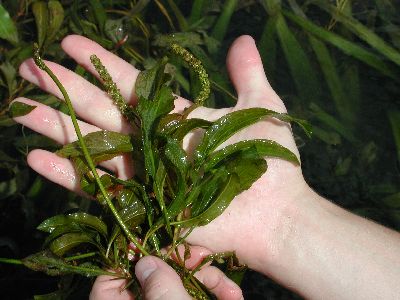Ecological Importance
Illinois Pondweed provides forage and cover for aquatic animals; the tuber is an important source of food for waterfowl. The Illinois pondweed is found in lakes, ponds and rivers.
Problems
Dense populations of plants reduce the water temperature and oxygen concentrations when plants die in late summer. Illinois Pondweed may form dense mats and block sunlight for other submersed vegetation species along with interfering with fishing, boating and swimming.
Plant Description
Illinois Pondweed has stout stems that emerge from a thick rhizome. Most of the submerged leaves are lanced shaped to oval and either attached directly to the stem or have a short stalk. The leaves have 9-19 veins and often have a sharp needle like tip. The stipules are free in the axils of the leaves and have two prominent ridges called keels.
Hints to Identify
Illinois pondweed is similar to American pondweed, and can be easily confused. Illinois Pondweed (potamogeton illinoensis) has slightly heart shaped leaves particularly at the base on a long stem. The petiole is shorter than that of the floating-leaf pondweed.
Common Application Questions
Q. How much should I treat?
A. Spot treat as needed to maintain navigation channels and swimming areas. Remember this plant is very beneficial and should not be treated where it is not a nuisance.
Q. When is the best time to treat?
A. Once water temperatures are around sixty degrees or warmer however this plant responds equally well to herbicide treatment when mature.
Q. How often do I need to treat Illinois Pondweed?
A. One treatment per season is usually enough.
Q. How long before I see results?
A. Generally within two to three weeks things will be cleared up.
| Homeowner Treatment Options |
| Aquathol K |
| Aquathol Super K |
| Hydrothol Granular |
| Sonar AS |
| Sonar RTU |
| *Aquatic Biologists recommends implementing preventative management techniques and physical removal prior to, or in conjunction with treatment. |

